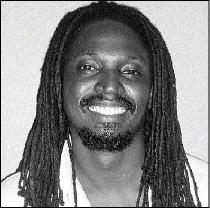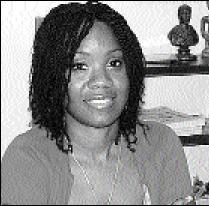Museums changing people's lives
Published: Sunday | July 19, 2009


Photo by Laura Tanna
LEFT: Wayne Modest, former director of the Museums of History and Ethnography, Institute of Jamaica, now head of anthropology at Horniman Museum and Gardens in London, England.
Contributed
RIGHT: Staci-Marie Dehaney, new director of the Museums of History and Ethnography, Institute of Jamaica.
Laura Tanna, Contributor
I was asked to serve on the board of the Museums of History and Ethnography last year and my first thought was: "Whoa, isn't that the place downtown with the stuffed Manatee?" My second thought: "I served on the Council of the Institute of Jamaica (IOJ) for over a decade in the '80s, is this a demotion?"
Then I met Wayne Modest, a dreadlocked Rastafarian whose calm passion about the museums made all my doubts disappear. He had risen through the ranks of the Museum Division to become its director and as he spoke to me last year, he described how the museums had changed his life.
Born March 23, 1972, in Bog Walk, St Catherine, his father a technician and his mother a postmistress and telephone operator until they worked together in their own electronics store before retirement. Modest remembers at age nine, moving to Ensom City in Spanish Town and thinking how they'd come up in the world. His mother dreamed of his becoming a doctor, a dream he shared on entering the University of the West Indies (UWI) at Mona where he majored in chemistry. He had just one semester to complete his degree, "but it just didn't feel right," he said. "That's when I started working at the IOJ."
"I've always been interested in the arts. In high school, I sang with the school choir. When I went to UWI, I was in theatre and did plays with Norman Rae. When I reached the Institute of Jamaica, at that moment the objects and being involved with history, ethnography and art made me feel there was a good marriage between applied sciences and my own interests in the arts. The museum was the place where I could do that. I finished my degree in chemistry, but being at the institute made me feel I was home. This was the beginning of my intellectual journey, the beginning of my career. Museums is where I want to be!"
Wayne Modest continued: "The head of the IOJ was Elaine Fisher. She was really an inspiration as a scientist and took me on, she said, as her third son. The Museums Division was there, but non-existent, really. Nothing was happening. Michael Cooke was working in a development post and took on the museums to become its head. He was the person who had the most influence on me. I was with him from 1994 until 1997. He did so much to revitalise the museums, by revitalising collecting and how we started to think about storage. I was made conservation officer."
Modest developed a lab for restoring and conserving the collection and at a summer workshop, met visiting scholar John Burke, the conservator at Oakland Museum. Modest accepted an Organisation of American States-sponsored visit of a month to California where he saw the conservation facilities at the Asian Art Museum in San Francisco and at Oakland. Says Modest: "That experience of being out there and seeing what could be done started me to think about techniques. I already had competency in conserving ceramics. I came home and used my chemistry knowledge but every time I had a problem, I could call John Burke and ask what treatment I should use for a particular material and that is how our knowledge developed."
Concerned that he still didn't know enough, Modest applied for scholarships and was offered one to the Rhinwardt Academy in Amsterdam, where he completed a master's degree in museology. His thesis, titled, 'Prevention Better Than Cure', questioned international conservation standards as to whether they are actually suited to Caribbean conservation considering our tropical climate. He calls his work in Amsterdam, 1997 to 1999, a wonderful experience with an excellent mentor. There, he developed an interest in the anthropological aspects of museums, and the philosophical understanding of museums' ethics. Meeting with the head of the collection where he did his master's research, he remembered: "She said something really important to me: 'You have to decide what you want to do. Do you want to fix pottery for the rest of your life, or do you want to affect policy, to ensure heritage is preserved?' When I came back I implemented through Michael stronger preventive conservation methods at the institute: better handling, cataloguing, and trying to control the environment to be sure we don't damage anything."
Comprehensive system of care
Modest noted: "We've put together a comprehensive system of care, which ensures accountability and this does not depend on me. We have a manual of museum practice, which tells not only how staff should treat objects, but what happens when objects come into the institute; what a contract is with a donor. We have a database so that everything is put into the database with codes limiting access and areas are secured. Once someone gives something to the institute museum we can press a button and know where it is."
As a board director, I've visited the storage area and seen the most amazing collection of African masks and carvings donated by a Venezuelan Ambassador in the 1960s, which would again make a marvellous exhibit if funds could be secured. As it is now, The Museums of History and Ethnography, not to be confused with the Natural History Division of the IOJ, comprise the Military Museum at Up Park Camp, the Museum of St James in Montego Bay, the People's Museum in Spanish Town, the Museum at Port Royal, and the Museum in Lucea, Hanover, created by Mrs St Clair, but the Taino Museum at White Marl is currently closed for security reasons, though the Taino site is preserved for future excavations. Currently, there are two exhibitions at the downtown venues that should not be missed.
"A lot of what prohibits us from using downtown is fear, and it's not real," Modest maintained from experience. "The IOJ demonstrates that if you develop strong and good relationships with what we call difficult communities, then you can have a brilliant relationship. When we change our perception of downtown, we'll be able to use downtown much better." He remembers in 2006 having an exhibition opening and function to honour IOJ Chairman Barry Chevannes from 7 until 9 p.m. One hundred and twenty people came out and really enjoyed themselves. Said Modest: "It is a policy to try to engage people from our downtown community as well as people from uptown. I think the IOJ is part of the government's statement that we are committed to downtown Kingston."
He noted their neighbour, the legal firm, Myers, Fletcher and Gordon, has been especially supportive.
Difficult communities
Michael Cooke left in 2000 and Modest became acting director, then director of the museums. Now married to a Dutch woman who has an excellent job in Holland, and nearing completion of a doctorate at UWI, Modest accepted a job as head of anthropology at the prestigious Horniman Museum and Gardens in London last September to be closer to his wife, but not before saying that he was leaving at the Museums Division an amazing staff of some 35 to 40, including temporary workers. If he had a wish list, he would like other staff members to have training opportunities abroad to return and develop the IOJ as he did.
He says museums' staff are preparing kits to assist teachers, but he'd like equipment so that after all the work of putting together exhibitions, they could produce catalogues for sale, as their graphics staff is excellent. Flexi-time might permit occasional weekend openings; staff are civil servants and weekend work requires extra payment. Salaries take much of the museums' budget so exhibitions require careful planning. KSAC allowing cuts into the surrounding sidewalks might help the parking situation, but he'd like more adults to realise that the Museums are fascinating places which can enrich their lives!
Although Wayne Modest is a hard act to follow, and despite applications from abroad, the new director of the Museums of History and Ethnography, Staci-Marie Dehaney, is no stranger to the museums. She just completed her MBA from Florida International University (FIU), already has an MA in heritage studies from UWI, and guess what? When she toured the IOJ Museum for her heritage master's studies, she so fell in love with the objects that she interned, became assistant curator, studied overseas at the Malaysian Government National Archives, returned to become acting keeper of collections and once more a life was changed! But, we'll let Miss Dehaney tell her story another time.
Current Exhibitions:
Xaymaca: Life in Spanish Jamaica 1494-1655. Until August 13. Free entry.
Port Royal Jamaica, 10 East Street, entry $200 adults, $100 teachers and students over 16, $50 children, $40 students in uniform or with school ID, aged 6 to 16. Groups call Tour Booking Department 922 0620-6 to arrange a guided tour. Open Mon-Thurs 9 a.m.-4:30 p.m., Friday, 9 a.m.-3:30 p.m. Closed Saturday and Sunday.
